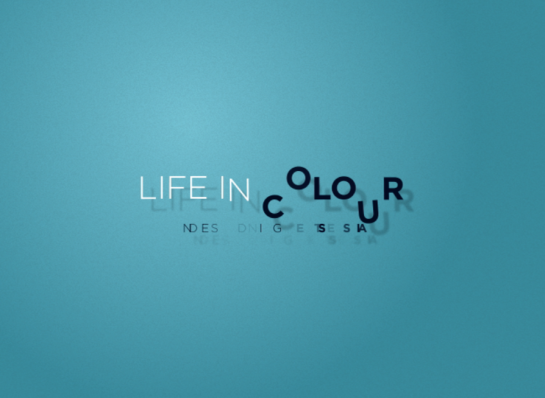Goal of the Project
The goal of my project is to create a clear and aesthetic video infographic that will inform viewers both visually and audibly about synesthesia and its impacts. I will first be introducing a broad picture of the often unknown neurological disorder, while describing and giving examples of interesting synesthetic experiences and perceptions. I also aim to address the true benefits of synesthesia as well as its most popular disadvantages. I will be using graphics, quotes, synesthetic people’s voices, statistics as well as music to approach my subject. I will build upon my previous research in order to define the content of the video infographic. I am also planning to remix voices found in different synesthete interviews on the Web. Finally, I will be using vector icons and textures to illustrate my discourse. Below is an overview of my creation process as well as sketched storyboard of my animation.

A Mango-Shaped Space, by Wendy Mass
A Mango-Shaped Space
This book written by Wendy Mass, was my first real contact with the concept of synesthesia. I was about 12 years old when I read it. And as far as I can remember, I chose it in my High School’s library mainly because the cover felt attractive. At first, I thought I was dealing with a fantasy book, or some kind of weird fictional story. But doing some small research, I realized that Mia Winchell, the teenager main character of the book, had a neurological disorder did really exist and that was present in 2% to 4% of the population. At that moment, I became pretty obsessed with the subject.
Expo-Science Bell 2008
In fact, I decided to team up with one of my best friends Grégory Calonges and build a vulgarization project about synesthesia. We presented our research at school, and also attended the regional final Expo-Science Bell contest in 2008.
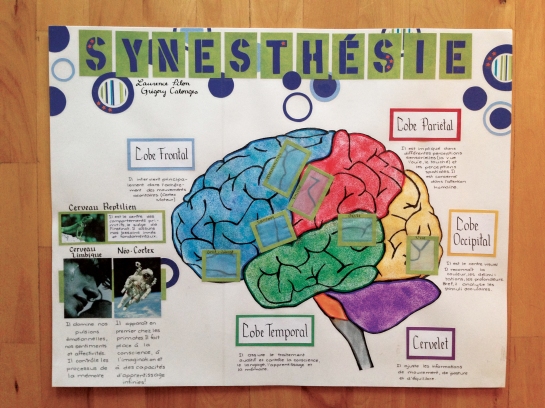
Synesthésie, par Grégory Calonges et Laurence Pilon

Synesthésie, par Grégory Calonges et Laurence Pilon
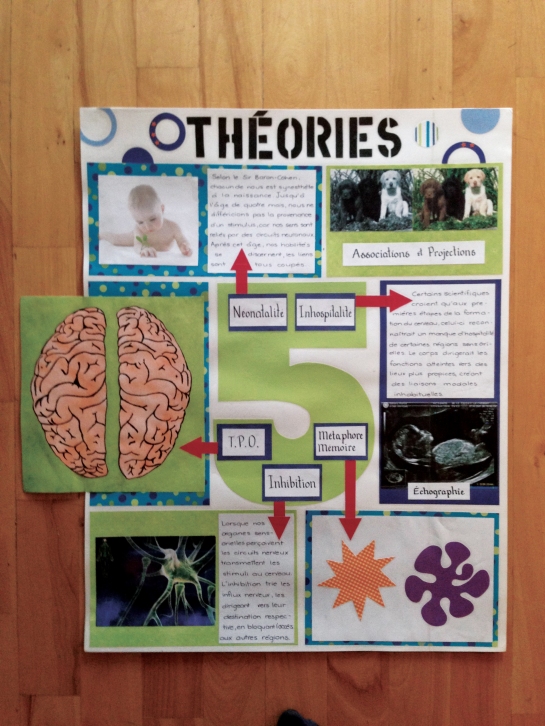
Synesthésie, par Grégory Calonges et Laurence Pilon
An Eyeful of Sound
Synesthesia is often defined as being a “cross-wiring” of the senses. Synesthetes may experience colors, shapes, sounds, odors, tastes and feelings in tandem with any other of their senses. Some say it’s a disorder, while others say it’s a superpower. In fact, it is a neurological condition in which reality is perceived in a completely different way.
Scientist are still doing a lot a research to explain what causes synesthesia exactly. Opinions diverge. Half of the researchers think that synesthetes have more wires in their brain connecting the parts of it that react to different stimuli. The other half believe that everyone has the same brain structure since people can experience synesthesia (with drugs such as LCD). It would perhaps exist in all of us. The difference between a “normal” brain and a synesthete brain would lay in the balance between excitation and inhibition of sensory activity.
It is important to note that perceptions experienced by synesthetes are totally automatic and involuntary. They are not hallucinations though. A color-grapheme synesthete for which the letter “A” is blue for example knows that it is printed in black ink or displayed in black on a computer screen, but he would still experience the sensation of the color blue when seeing the letter “A”. Synesthetes are capable of distinguishing perceptions of their eyes and perceptions of their mind’s eye.
“An Eyeful of Sound” was created from a collaboration between animator Samantha Moore, Jamie Ward as well as a group of audio-visual synesthetes. The latter have strong visual reactions to sound. When they hear music or speech, they experience colours, movement and shapes. This short documentary video won many awards: Winner of the Nature Award for Scientific Merit Imagine Science Film Festival New York 2010, Winner of Best Experimental/Animation Scinema Science Film Festival Australia 2010 and Documentary Diploma Flip Animation Festival UK 2010 (www.samanthamoore.co.uk).
The blending of many voices and layers of colors in the video give non-synesthetes an idea of what life can be as a real synesthete. I also appreciated the simplicity of the animated graphics. (Click on one of the two images above to view the video on Vimeo).
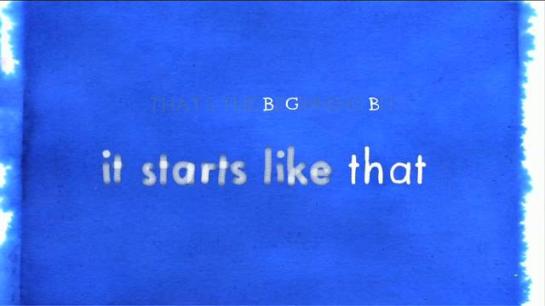
An Eyeful of Sound, by Samantha Moore
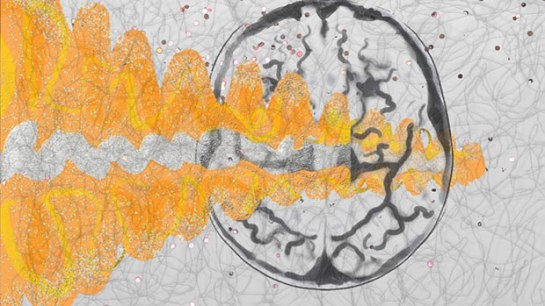
An Eyeful of Sound, by Samantha Moore
TED Talks
My boyfriend listens to a hudge amout of TED talks, these 3 to 8 minutes sketches in which PHDs describe the whole point of the thesis they have been working on sometimes since the last 5 years. He is the type of person that takes the adage “Learn something new everyday!” to heart. He is also an auditive person, and likes listening to documentaries and educative pod casts all the time. I am more of a visual person, and do not have the patience or the ability I would say to listen closely to people talking. Even if their subjects or their tone of voice is interesting, I often quickly lose track. Especially when it comes to PHDs getting into complexe concepts and unfamiliar subjects. Our different learning preferences inspired me to create a video infographic about synesthesia, knowing that for some people, information is easier understood when it’s heard, and for others, when its actually seen. For me, TED talks are not complete unless supported by graphics, charts,
or pictures.
Research
Synesthesia is often defined as being a “cross-wiring” of the senses. Synesthetes may experience colors, shapes, sounds, odors, tastes and feelings in tandem with any other of their senses. Some say it’s a disorder, while others say it’s a superpower. In fact, it is a neurological condition in which reality is perceived in a completely different way.
Scientist are still doing a lot a research to explain what causes synesthesia exactly. Opinions diverge. Half of the researchers think that synesthetes have more wires in their brain connecting the parts of it that react to different stimuli. The other half believe that everyone has the same brain structure since people can experience synesthesia (with drugs such as LCD). It would perhaps exist in all of us. The difference between a “normal” brain and a synesthete brain would lay in the balance between excitation and inhibition of sensory activity.
It is important to note that perceptions experienced by synesthetes are totally automatic and involuntary. They are not hallucinations though. A color-grapheme synesthete for which the letter “A” is blue for example knows that it is printed in black ink or displayed in black on a computer screen, but he would still experience the sensation of the color blue when seeing the letter “A”. Synesthetes are capable of distinguishing perceptions of their eyes and perceptions of their mind’s eye.
Fun Facts
• “To people with number-color synesthesia, Roman Numerals have no color” (Emily).
• “There was once a colorblind synesthete who only saw colors when he looked at numbers” (Emily).
• �”Synesthesia has been proven to be more common in women and left-handed individuals” (Emily).
• �”People that started experiencing synesthesia as a result of a head trauma or incident have “acquired synesthesia”, and those that have always had synesthesia have “developmental synesthesia”” (Emily).
• �“The word “Synaesthesia” comes directly from the Greek (syn-) “union”, and (aísthesis) “sensation”, thus meaning something akin to “a union of the senses”. “Synaesthesia” is the British English spelling of the word; in American English, it is often spelled “Synesthesia”, without the “a”” (Emily).
• “Synesthesia can be very weird too. You can taste something weird when the spelling is different, like for an example, there was a man who thought that “lori” tasted like a pencil’s eraser, however, “Laurie” might taste like lemon. For instance “cat” may taste dark chocolate, while “kat” can taste like red wine” (Lee).
Aesthetic Inspiration
Throughout my video infographic, I wish to develop a clean vector aesthetic. I will do so by using slick typefaces, simple icons, a limited color palette and subtle textures. My main inspirations were taken from a variety of infographic videos*.
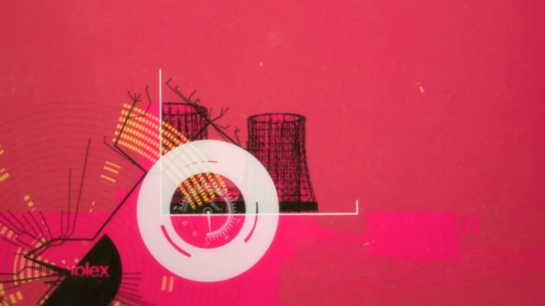
Virus
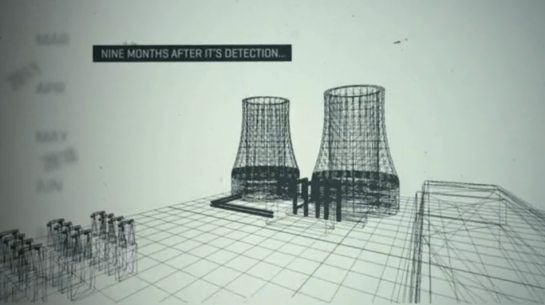
Virus
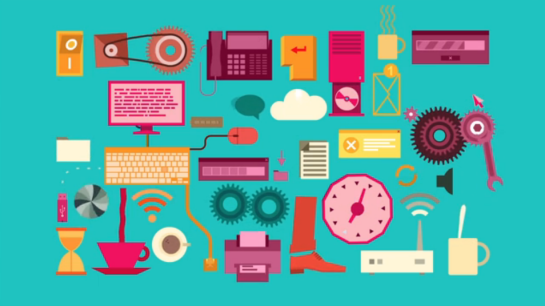
VCast Software
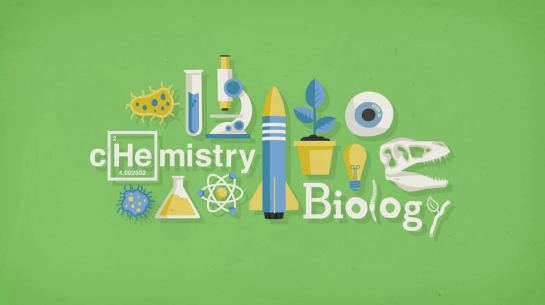
Gearing Up for College
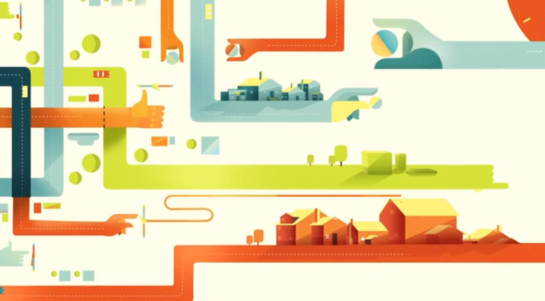
Flex Alert Program
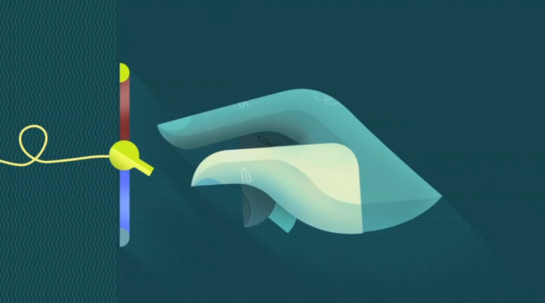
Flex Alert Program
Transitions
I am particularly interested in transitions. I think that beautifully executed and original transitions give an animation all of its richness. These two examples inspired the creation of my storyboard. I paid lots of attention to how elements interact with each other and how the come into and out of scene. I wish to create hierarchic levels of interest while directing my viewers eye throughout the whole video.
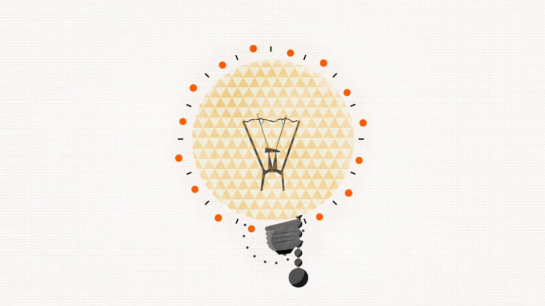
BBC
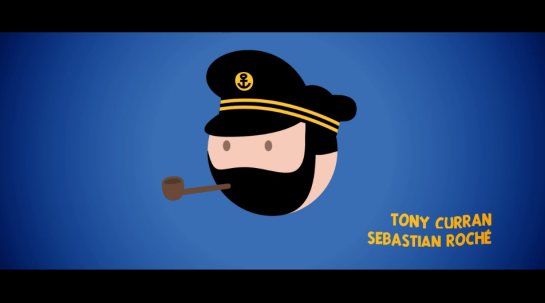
The Adventures of Tintin
Storyboard
The following is a preliminary storyboard of my animation. I will probably move things around while working on the project. But still, it gives a good idea of what I am planning to achieve!
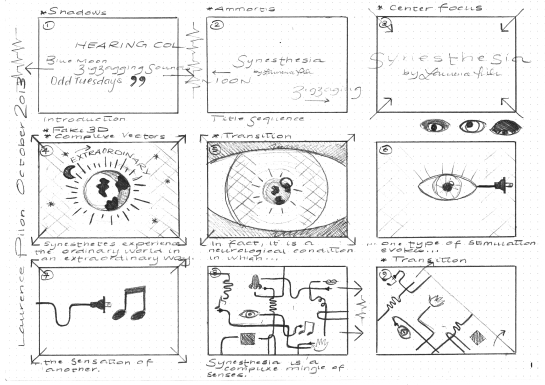
Synesthesia Storyboard, by Laurence Pilon
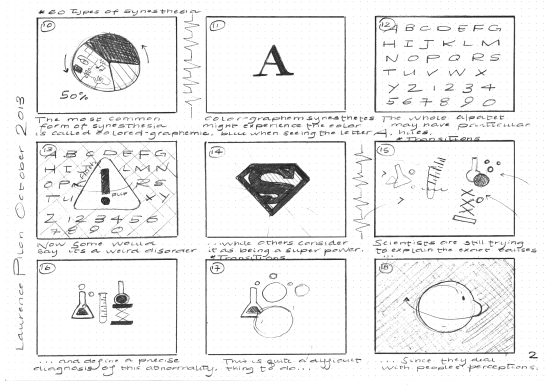
Synesthesia Storyboard, by Laurence Pilon
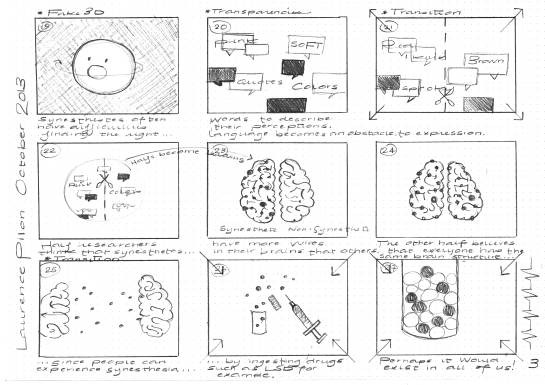
Synesthesia Storyboard, by Laurence Pilon

Synesthesia Storyboard, by Laurence Pilon
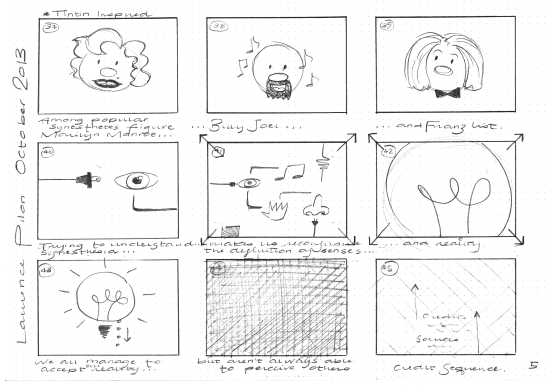
Synesthesia Storyboard, by Laurence Pilon
1. INTRODUCTION
Action: Quotes from synesthetes move over and across the screen.
Sound: Mixed voices of synesthetes say the quotes that are on the screen and other random facts about their condition.
2. TITLING SEQUENCE
Action: The title of the video comes bouncing in the middle of the screen.
3. TRANSITION
Action: The camera moves forward “into” the title.
4. EXTRAORDINARY WORLD
Action: The planet Earth appears on a background of stars. The moon is rotation around the Earth. The word ordinary, spelled over the planet becomes extraordinary when the narrator pronounces it.
Narration: Synesthetes experience the ordinary world, in quite an extraordinary way.
5. TRANSITION
Action: The camera moves away from the Earth to reveal an eye.
Narration: In fact, it is a neurological condition in which…
6. & 7. SENSE CONNECTION
Action: The eye blinks randomly. An electricity cable pops out of behind of it and moves across the screen towards music notes to create a visual connection between senses.
Narration: …one type of stimulation evokes the sensation of another.
8. COMPLEX MINGLE OF SENSES
Action: The camera moves away from the music notes to reveal a complex pattern of senses and connections. Wires move, eyes blink, music notes bounce, etc.
Narration: Synesthesia is a complex mingle of senses.
9. TRANSITION
Action: The pattern is tossed away from the viewers vision a few seconds to become part of a pie chart.
Sound: Mixed voices of synesthetes say random thoughts and facts about their neurological condition.
10. PIE CHART
Action: A spinning pie chart reveals the most common form of synesthesia.
Narration: The most common form of synesthesia is called colored-graphemic synesthesia.
11. A
Action: A black letter A appears on the screen, bouncing off the pie chart. It turns blue randomly.
Narration: Color-graphem synesthetes might experience the color blue when seeing the letter A, even when displayed in black ink or pixels.
12. ALPHABET
Action: The camera moves away from the letter A, revealing the whole alphabet. Letters’ color switch from black to real color randomly.
Narration: The whole alphabet may have particular color hues.
13. DISORDER
Action: A big rotating “!” sign covers all of the alphabet in the very middle of the screen.
Narration: Now some may consider this as being a weird disorder…
14. SUPER POWER
Action: The “!” sign rotates and transforms into the Superman logo. The alphabet disappears. Rays of color appear in the background.
Narration: …while others consider it as being a super power!
15. & 16. TRANSITION
Action: Mixed vectors fly across the screen to create elements of a scientific laboratory.
Narration: Scientists are still trying to explain the exact causes of synesthesia and define a precise diagnosis of this abnormality.
17. TRANSITION
Action: Bubbles from a test tube enlarge to transform into a round human head.
Narration: This is quite a difficult thing to do…
18. & 19. ROTATION HEAD
Action: The round head rotates from left to right.
Narration: …since they deal with peoples’ perceptions.
20. SPEECH BUBBLES
Action: Speech bubbles start covering the round head. All kinds of attributes gather everywhere on screen.
Sound: Synesthetes voices cover one another in a “anxious” way.
Narration: Synesthetes often have difficulties finding the right words to describe their perceptions. Language becomes an obstacle to expression.
21. SCISSORS
Action: Speech bubble fall down as if they were now resenting the effect of gravity. A huge pair of scissors starts cutting the background in half. The camera moves away from the scene to reveal a circle that is being cut in half.
Sound: Synesthetes all stop talking at once.
22. HALF RESEARCHERS
Action: The circle gradually transforms into a human brain seen from top.
Narration: Half researchers think that synesthetes…
23. FIRST THEORY
Action: The left part of the brain represents a synesthetes’ brain, while the right part represents a “normal” one. Little flashing circles appear on the left part to represent connections.
Narration: …have more connection wires in their brains than others do.
24. SECOND THEORY
Action: Little flashing circles also appear on the right part to represent equality between the synesthetes’ brain and the “normal” brain.
Narration: The other half believes that everyone has the same brain structure…
25. TRANSITION
Action: The two parts of the brain roll out of the screen. Little circles become drug pills and fall into a container.
Narration: …since anybody can experience synesthesia by ingesting drugs such as LSD for example.
26. SYRINGE
Action: A syringe helps pills entering the container and flies out of the screen.
27. TRANSITION
Action: The camera moves “into” the container. Pills become a background for the next scene.
Narration: Perhaps it would exist in all of us!
28. & 29. MECHANIC GEARS
Action: Pills transform into spinning mechanic gears.
Narration: The difference between a normal brain and a synesthetic brain would lay in the balance between excitation and inhibition sensorial activity.
30. & 31. DIZZY HEAD
Action: Gears fly off the screen, revealing a dizzy head rotating from right to left. Little birds fly around the head.
Narration: One thing is sure though that perceptions experienced by synesthetes are automatic and involuntary.
32. NOT HALLUCINATION
Action: A big “X” sign covers the dizzy head.
Narration: They are not hallucinations. They are experiences…
33. MIND’S EYE
Action: The head’s brain transforms into an eye.
Narration: …of the mind’s eye.
Action: Synesthetes’ voice are mixed together. They comment on the narrator’s sayings.
34. 2 & 5 TEST
Action: A whole bunch of organized 5s bounce on the screen. The “invisible” 2s change color to form a real triangle.
Narration: Synesthesia can be quite annoying, but most synesthetes use their special ability in a positive way. They use it to decode complex visuals…
35. MATHS
Action: Colourful math formulas appear on screen.
Narration: …memorize things…
36. MUSIC
Action: Music instruments appear on screen. Notes move, piano keys play music, etc.
Narration: …and even compose music.
37. MARILYN MONROE
Action: A circle rolls into the middle of the screen and transforms into Marilyn Monroe.
Narration: Among popular synesthetes figure Marilyn Monroe…
38. BILLY JOEL
Action: Marilyn Monroe transforms into Billy Joel (inspired from The Adventures of Tintin animation).
Sound: A short sequence of Billy Joel’s “Piano Man” plays.
Narration: …Billy Joel…
39. FRANZ LIST
Action: Billy Joel Transform into Franz List.
Sound: A short sequence of Franz List’s piano composition plays.
Narration: ..and Franz List.
40., 41., 42. & 43. ENDING
Action: The connection pattern used previously reappears on screen.
Narration: Trying to understand synesthesia makes us redefine the definition of reality. We all manage to accept our own reality, but aren’t always able to accept the other’s reality.
44. TRANSITION
Action: The screen gradually becomes black.
45. CREDIT SEQUENCE
Action: All sources and participants are listed. They move from bottom to top, just like in cinema movies.
Computer Sketches
Below are some of my first computer sketches. I can’t wait to show you more work in progress as well as my final animation!
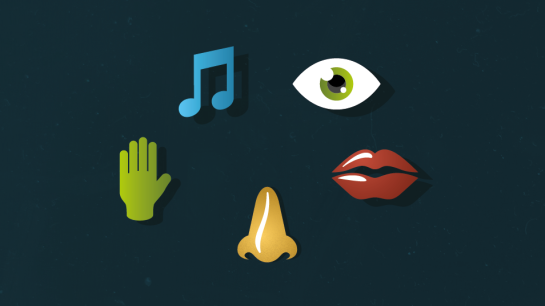
Synesthesia Computer Sketches, by Laurence Pilon
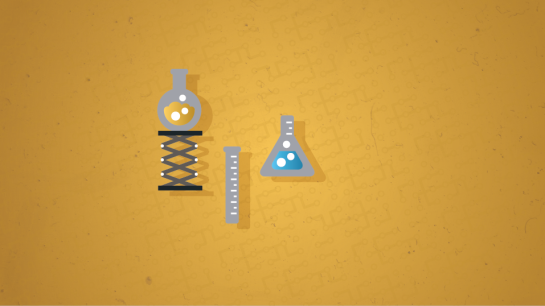
Synesthesia Computer Sketches, by Laurence Pilon

Synesthesia Computer Sketches, by Laurence Pilon

Synesthesia Computer Sketches, by Laurence Pilon
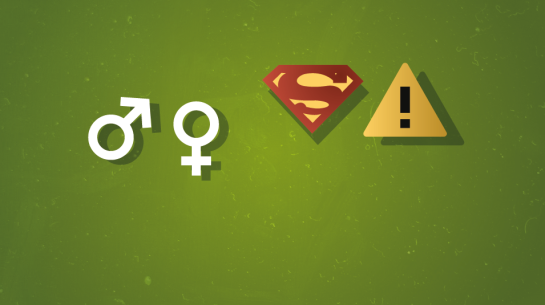
Synesthesia Computer Sketches, by Laurence Pilon
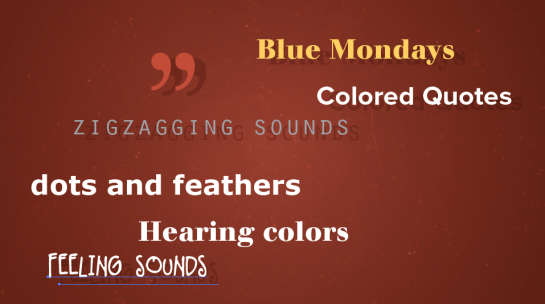
Synesthesia Computer Sketches, by Laurence Pilon
Sources
Barros, Nello. Kinobrand. Geneva, Lausanne, 2010. Web. 22 Oct. 2013. – http://kinobrand.com/extra-brain-wiring-synesthesia-design-interview/
Dixon, Mike J.; Smilek, Daniel; Duffy, Patricia L.; Zanna, Mark P. and Merikle, Philip M.. “The Role of Meaning in Grapheme-Color Synaesthesia.” Cortex 42 (2006): 243-252. Department of Psychology, University of Waterloo, Waterloo, Ontario, Canada. Web. 22 Oct. 2013.
Emily. Synesthesia: The Crossing of the Senses – One of the 9 Most Extraordinary Abilities of Humans. Weebly Website, ND. 22 Oct. 2013. http://space-timesynesthesia.weebly.com/me-and-my-synesthesia.html
Lee, Dayoon. Synesthesia Survey. WordPress Blog, 2011. Web. 22 Oct. 2013. http://surveyforsynesthesia.wordpress.com/
Red Mondays and Gemstone Jalapenos: The Synesthetic World. UWTV. 14 July 2011. Video. – http://www.youtube.com/watch?v=CtO4CSzAyxE
“The Otherside of Consciousness.“ Marcia Smilack Reflectionist. NP, 2013. Web. 22 Oct. 2013 – http://www.marciasmilack.com/synethesia-intro.php
Ward, Jamie. “Emotionally Mediated Synaesthesia.” Cognitive Neuropsychology 21-7 (2007): 761–77. Rpt. University College London, UK. Web. 22 Oct. 2013.
“Welcome to Synesthesia Research.” University of Sussex. NP, 2013. Web. 22 Oct. 2013. – http://www.sussex.ac.uk/synaesthesia/topics
